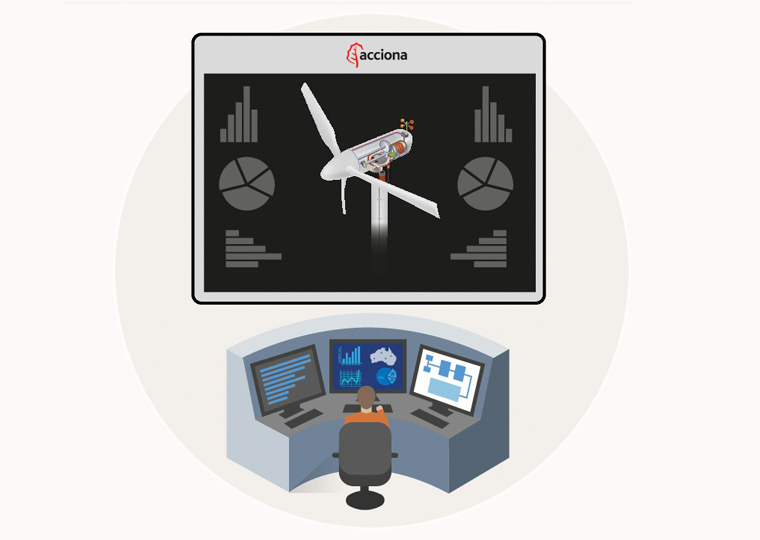-
Discover how all of ACCIONA's production in the world is managed from a small Spanish town
-
You will certainly have heard at some time or other of the butterfly effect. This chaos theory concept relates to how an insignificant event like a butterfly beating its wings in some obscure place can unleash a hurricane on the other side of the world via a chaotic process of amplification: the flapping of a butterfly in Hong Kong can unleash a storm in New York.
Similarly, a situation such as a low level of oil in the gearbox of a wind turbine generator in Waubra (Australia) generates an instantaneous reaction in Pamplona (Spain) – over 10,000 kilometers away – where a protocol is launched to correct the incident. What happens, though, has nothing to do with chaos theory; on the contrary, we are in ACCIONA’s Renewable Energy Control Center, CECOER, which manages all the company’s electricity production. Read on to find out what this giant technological brain represents and how it works.
-
Manning the clean energy control bridge
The CECOER is the biggest control center for renewable facilities in the world. From its location in Sarriguren, on the outskirts of Pamplona in Spain, the center manages all the company’s electricity generation plants worldwide as well as those of third parties, and it has four main responsibilities:
- Permanent supervision of the operation of wind farms, hydro stations, photovoltaic, solar thermal and biomass plants
- Immediate detection of incidents at any facility and remote correction, usually locally coordinated
- Energy management through own forecasting models and real-time sending of information to the operator of the electricity grid in each country
- Data recording and analysis to optimize the efficiency of the plants
-
In practice, this means that the CECOER is on alert 24 hours a day, 365 days a year, to supervise all the renewable energy facilities the company operates the world over, detecting, recording and responding to any incident that might occur. In parallel, the CECOER communicates the production forecast for the hours to come to the electricity system operator in each country, as well as the real-time production of each installation, i.e. it anticipates how much energy each facility is going to generate after analysing the weather forecasts. Likewise, it attends to and applies the instructions sent by the system operator to reduce or increase the energy produced at any given moment, thus maintaining the stability of the electricity grid.
-

-
Participate in our quiz!
How much energy does CECOER manage?
-
Meanwhile, the Renewable Energy Control Center functions like a gigantic technological brain processing and storing millions of data from all the facilities for ensuring their correct operation, foreseeing the energy that will be produced in the coming hours and recording what is being generated at each moment. The CECOER demonstrates, day after day, that a high proportion of renewable energy can be integrated into the electricity system with maximum security and reliability.
-
Inside the brain of ACCIONA
Experiencing a working day in the CECOER, the operations center of ACCIONA, is like attending a perfectly choreographed waltz. As many as 80 people work in continuous shifts, with an imposing 11m2 screen presiding over the room, to ensure the correct operation of all the company’s plants.
Engineers supervise, and offer remote assistance to, more than 400 electricity generating plants and 270 transformer substations in 20 countries, and any possible incident is monitored in real time so it can be remedied. Every year, over half a million incidents are dealt with, 60% of which are remedied remotely, a percentage that is constantly rising, with the aim of optimizing the availability of the facilities. When it is not possible to resolve a problem remotely, the CECOER immediately contacts local engineers on the ground to resolve the incident as swiftly as possible.
Thanks to this continuous control by the CECOER, the company successfully manages nearly 14,000 Megawatts, a renewable capacity equivalent to that of 14 mid-sized nuclear power stations.
The CECOER is always alert to ensure clean and sustainable energy is supplied on five continents
If you enjoyed reading this story, discover more like it at ACCIONA.
-
-
Sishen: where the sun's the limit
The photovoltaic plant supplying clean energy to tens of thousands of South Africans is, in itself, a colossal feat of engineering
-
-
-
-





